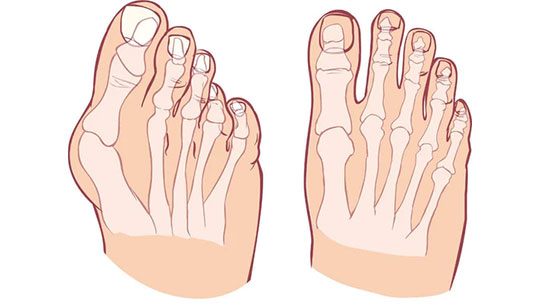Hallux Valgus
Hallux Valgus occurs when the big toe starts to deviate inward and a bump begins to develop on the inside of the big toe over the metatarsal bone. This condition is the process which develops into a bunion. The tissues surrounding the joint then tend to become swollen and tender.
WHAT CAUSES HALLUX VALGUS?
Although Hallux Valgus and bunions are generally hereditary, shoe wear can cause abnormal pressure or rubbing which can lead to bunion development.
HOW DO I KNOW IF I HAVE HALLUX VALGUS?
WHAT ARE THE SYMPTOMS OF HALLUX VALGUS?
- Shift of the big toe inward toward other toes.
- Irritated skin around the bunion as well as joint redness and pain.
- Pain when walking.
- Blisters form easily.
- Shoes don’t fit properly.
HOW IS HALLUX VALGUS DIAGNOSED?
Your physician will generally do a careful history and physical examination. Shoe wear will also be discussed. X-Rays may be suggested to allow the doctor to determine the appropriate treatment.
WHAT CAN I DO FROM HOME FOR HALLUX VALGUS?
WHAT CAN I DO TO PREVENT HALLUX VALGUS?
Since Hallux Valgus is primarily hereditary, there is little you can do to prevent Hallux Valgus from occuring. If Hallux Valgus and bunions run in the family always avoid wearing shoes that rub or apply pressure that is uncomfortable.
WHAT TREATMENTS CAN I DO FROM HOME FOR HALLUX VALGUS?
- Adapt shoe wear to fit the foot properly.
- Purchase bunion pads or toe spacers to splint the big toe.
WHEN SHOULD I SEE A DOCTOR FOR HALLUX VALGUS?
If you have tried all at home treatments and are still experiencing pain from the bunion caused by Hallux Valgus, schedule an appointment with your doctor.
TREATMENTS YOUR DOCTOR MAY RECOMMEND FOR HALLUX VALGUS
Non-Surgical:
Adapt shoe wear to fit properly without any pressure or rubbing.Toe spacers or splints may also be recommended
Surgical:
If all non-surgical measures fail to control the symptoms, surgery may be needed to remove the bunion, realign the big toe bones, and balance muscles around the joint.

